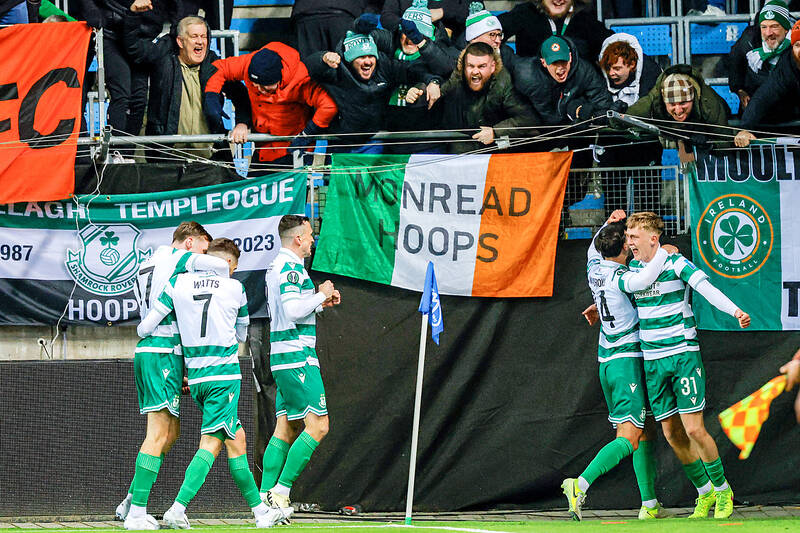Something special has been brewing in Irish soccer. Yesterday, Shamrock Rovers had the chance to become the first Irish side to reach the last 16 of a UEFA competition when they hosted Molde in their UEFA Europa Conference League playoff second leg, with a 1-0 advantage.
On Sunday, the League of Ireland’s attendance record was smashed, as more than 33,000 people watched Bohemians v Shamrock Rovers at the Aviva Stadium in Dublin.
Last month, Mason Melia, a teenage St Patrick’s Athletic striker, was signed by Tottenham for an up-front fee of 1.8 million euros (US$1.87 million), tripling the transfer fee record from the League of Ireland (Liam Scales’ 600,000 euros move to Celtic in 2021).

Photo: EPA-EFE
Just what is going on? Why is it now that League of Ireland teams are going deep into European competition, or domestic games are becoming so well attended? Why are clubs now able to demand record fees?
Melia’s fee is an exceptional one — mostly because he is an exceptional player — but also due to a confluence of other factors. The biggest reason is Brexit, which means Irish players cannot sign for English clubs until they are 18 years of age (despite already committing to Spurs, Melia would remain at St Patrick’s until January next year, past his 18th birthday).
Evan Ferguson’s move to Brighton in 2021 is the last example of a player younger than 18 moving from the League of Ireland to England in the records.
Traditionally, exceptional young Irish players such as Ferguson, Damien Duff and Robbie Keane would be snapped up on the cheap by British clubs before or on their 16th birthday, often with just a compensation fee to be paid. Brexit means this is not possible, so the 16-year-olds are signing professional deals with their League of Ireland clubs, meaning British clubs are now having to pay much larger sums to bring talent across the Irish Sea.
At 16, Melia signed a three-year professional deal at St Patrick’s last year and less than six months later Tottenham paid up.
“The situation in Ireland is new, that the best young talent has to stay in Ireland if they want to go to the UK,” said Clive Clarke, Melia’s agent and uncle.
A former Republic of Ireland international, Clarke understands the changes all too well, having left County Wicklow in 1996 aged 16 to join Stoke.
“When we sat down with St Patrick’s, they offered Mason a really good contract for his age, with incentives, but the whole thing was there to give the club that extra year to command a better fee, which is fair,” he said.
“There’s no problem staying in Ireland and playing men’s football because every club in the UK is trying to get their players out on loan to play men’s football and it’s becoming increasingly difficult,” he said.
“Mason is getting huge exposure [by staying in Ireland], but also getting that dressing-room feel for men’s football, playing in Europe and playing in front of a crowd,” he added.
Owing to Ireland’s EU membership, Irish players can move abroad to a club on the continental mainland at 16, and clubs across Europe are starting to realize that they can now steal a march on their British counterparts.
“They never really looked in Ireland previously because the best young talent were going over to the UK for next to nothing,” Clarke said. “But that has changed. Mason is a unique talent in that there are not many center-forwards of his caliber in Europe. There must have been nearly 100 phone calls from clubs all over Europe inquiring about his availability from the six months before he was 15.”
As demand has surged, so have the prices. With Irish teams going deeper into European competition, and the Republic of Ireland Under-17s reaching their first UEFA European Championship quarter-final in 2023, those players have also become easier to scout. Two members of that Euros squad, Naj Razi and Ike Orazi, have since, respectively, moved to Como in Italy and Stade de Reims in France for considerable fees.
The ability to sign top young professional talent in the League of Ireland has been beneficial all around, with the enhanced quality of soccer helping to drive the considerable rise in attendances. The record Aviva Stadium crowd of 33,208 might be something of an anomaly — with Bohemians renting the national stadium for a one-off game — but is symptomatic of a larger trend.
“After the [COVID-19] pandemic, I think people wanted to get out there and experience something,” Shamrock Rovers chief executive John Martin said.
“The English Premier League in Ireland is huge, but there’s now a disconnect with the finances. Watching it is expensive, on TV or travelling to the UK — it’s less accessible for people, with the cost of travel, tickets and hotels,” he said.
“So I think that’s led a lot of people to turn to the domestic game and experience something and be part of something, and that’s just grown and grown. So there’s been more revenue, and there’s been a perfect mix of factors that has led us to this point,” he added.
When Rovers’ Tallaght Stadium was built in 2009, attendances averaged between 2,000 and 3,000. Now averages are about 7,000 and the play-off yesterday with Molde was expected to be more than 10,000, a sellout.
Rovers’ winning goal in the first leg in Norway came from the 16-year-old Michael Noonan, who became the youngest scorer in UEFA competitions since 1991.
Rovers convinced the striker to sign a two-year professional contract last month with no release clause, which means they should be well compensated should any further interest arise — Manchester City are reportedly one of a number of clubs tracking the teenager.
“Michael could have signed for any club in Europe and that’s not an exaggeration,” Martin said.
“His decision to sign professionally for Rovers at 16 is an endorsement that Michael sees a pathway here. Playing senior soccer in Ireland and in European competition will enable him to get the right move to England or Scotland down the line. Because that is his preference.” he added.
Noonan’s mother went viral for posting a picture of her son off to school the morning after his match-winning goal in Norway.
“That’s not to say he wouldn’t sign for Real Madrid if they came in tomorrow,” Martin half-joked, “but getting a school education is another reason Michael stayed. He is very grounded, his family is very grounded.”
Issues do remain in Irish soccer. Broadcasting revenue is well short of what it should be. Academy soccer is still underdeveloped. Shelbourne’s prize money for winning the top flight last season (125,000 euros) was less than Shamrock Rovers received for drawing 1-1 with Apoel (135,000 euros) in the Europa Conference League in October last year.
The Football Association of Ireland (FAI) is still debt-ridden and “doesn’t give financial support to clubs in any way, shape or form,” Martin said.
“The FAI has 350 employees and a wage bill of 17 million euros, which is out of kilter with nearly every single football association in Europe.”
Despite all that, this is a hugely exciting time for the League of Ireland clubs. Elite young talent is thriving, transfer fees are finally starting to roll in and fans are flocking to watch their sides compete domestically and in Europe.
Shamrock Rovers might be the headline act this week, but this is not a brief moment in the sun for Irish soccer, it is a watershed.

Top seeds Alexander Zverev of Germany and American Coco Gauff on Tuesday advanced to the third round of the Canadian Open after both players were pushed hard by their opponents. World No. 3 Zverev, playing in his first match since his first-round loss at Wimbledon, was far from his best, but emerged with a 7-6 (8/6), 6-4 win over Adam Walton under the lights in Toronto. Momentum shifted firmly in Zverev’s favor when he won a 52-shot rally in the first set tiebreak and he sealed the win on a double fault by the Australian in the second set. “It was a very

Canadian teenager Victoria Mboko upset top-seeded Coco Gauff 6-1, 6-4 on Saturday night to reach the National Bank Open quarter-finals. “Your support was incredible,” Mboko told the crowd in French after a chorus of “Ole, Ole, Ole” chants echoed around the venue. “I’m really happy to win today ... It’s incredible. I’m so happy to beat such a great champion.” Gauff dropped to 2-3 since winning the French Open. She followed the major victory with opening losses in Berlin and Wimbledon, then overcame double-fault problems to win two three-set matches in Montreal. Gauff had five double-faults on Saturday after having 23 in

Taiwan’s top women’s badminton doubles duo, Hsieh Pei-shan (謝沛珊) and Hung En-tzu (洪恩慈), achieved a straight-sets victory over Japan’s Kaho Osawa and Mayui Tanabe at the Badminton World Federation (BWF) Super 300 Macau Open on Sunday. The Taiwanese pair won the final 21-18, 21-12, marking the duo’s second title this year after their win at the BWF Super 300 Taipei Open in May. The match on Sunday was their first encounter with the Japanese duo, ranked No. 63 in the world. Hsieh and Hung, ranked No. 12, began the opening game well. Hung, who plays left-handed, performed strongly at both the net and the

Formula 1 champion Max Verstappen on Thursday said that he is staying with the Red Bull team next year, ending months of speculation over his future. “Some people just like to stir the pot, some people just like to create drama, but, for me, it’s always been quite clear, and also for next year,” the four-time champion said ahead of the Hungarian Grand Prix. “I’m discussing with the team already the plans — the things that we want to change for next year, so that means that I’m also staying with the team for next year,” he said. Verstappen has a contract with